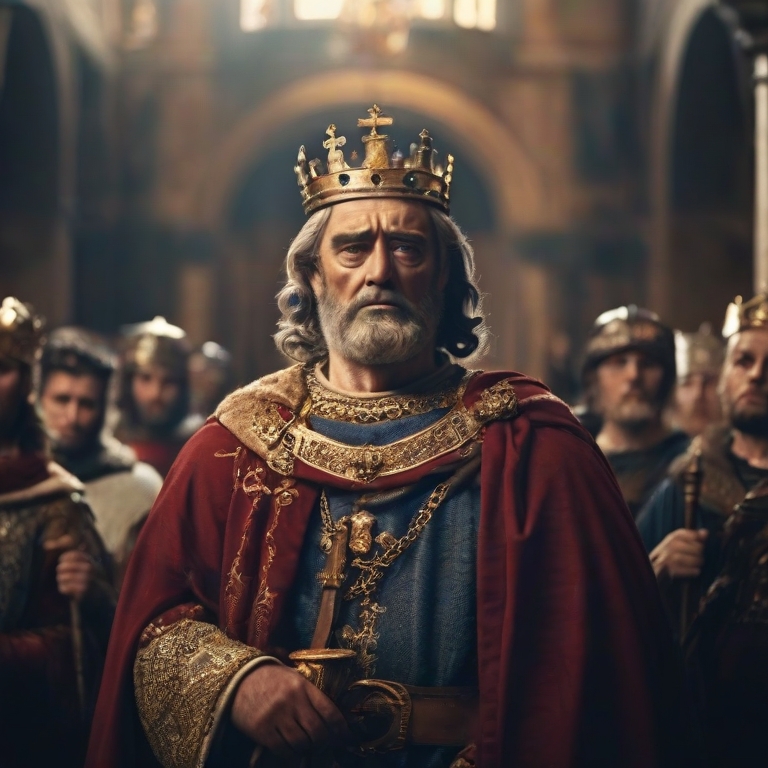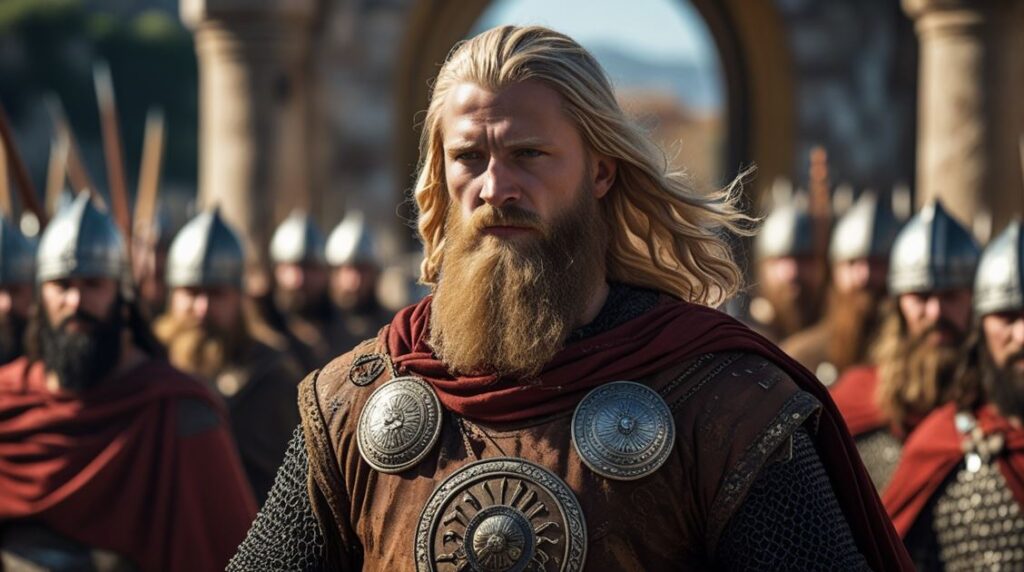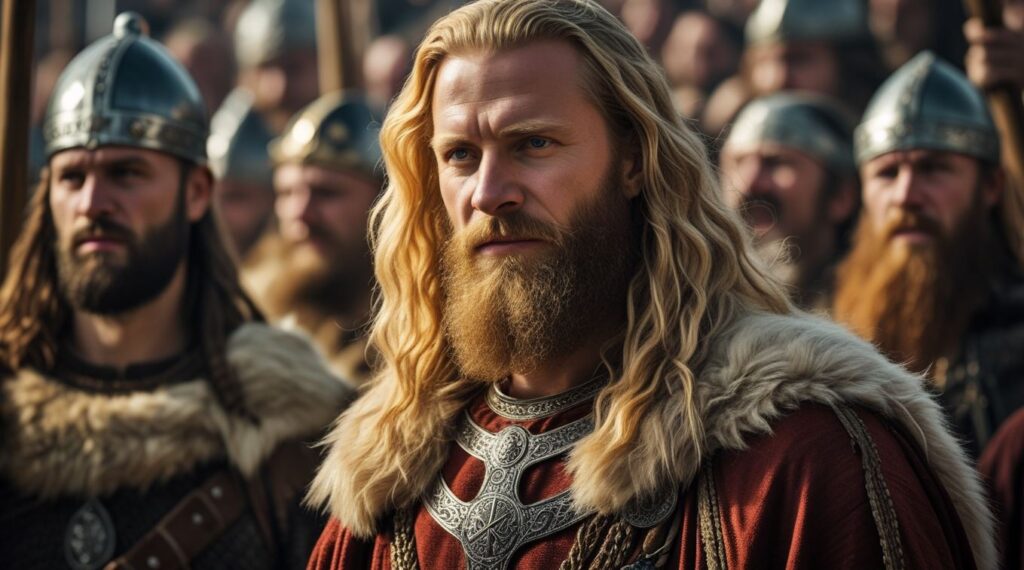Charlemagne, the ruler of the Franks, was crowned Holy Roman Emperor on December 25, 800, at St. Peter’s Basilica in Rome, by Pope Leo III.
The significance of this coronation extends far beyond a mere ceremonial affair. It symbolizes a profound impact it had on Europe’s socio-political landscape.
At the heart of this monumental event is Charlemagne, a charismatic and visionary leader who steered the Carolingian dynasty and Frankish Realm to unprecedented heights of power and influence.
In this article we explore layers surrounding the Crowning of Charlemagne, unraveling the complexities that defined this historical moment.
- 1. Charlemagne: The Man and the Vision
- 2. Charlemagne’s Key Achievements and Contributions
- 3. Charlemagne’s Coronation Ceremony
- 4. The Significance of the Collaboration Between Charlemagne and Pope Leo III
- 5. Charlemagne and the Creation of the Holy Roman Empire
- 6. Family Dynamics: Louis, Lothar, and Charles
- 7. Successor Dynasties
- 8. The Legacy of Charlemagne
- Further Reading
1. Charlemagne: The Man and the Vision
Early Life in the Shadows of the Carolingian Court
The second son of Pepin the Short and Bertrada of Laon, Charles (later known as Charlemagne) navigated the complexities of court politics from an early age.
Amidst the political turbulence of the time, the young Charles witnessed the astute leadership of his father, Pepin the Short, who, as the first Carolingian king, had seized the throne from the Merovingian rulers. This transition marked the beginning of the Carolingian ascent, setting the stage for Charlemagne’s eventual rise to power.
Charlemagne’s Ascension to the Throne
The trajectory of Charlemagne’s rise to power took a definitive following the death of his father.
Charlemagne’s father, Pepin the Short, died in 768. Pepin’s death marked a significant moment in the Carolingian dynasty, leading to the division of the Frankish Kingdom between Charlemagne and his brother Carloman.
However, Charlemagne became the sole ruler of the Frankish realm in the year 771. This occurred after the mysterious death of his brother Carloman, leaving Charlemagne as the sole surviving heir to the Carolingian dynasty. This marked the beginning of Charlemagne’s visionary leadership and the expansion of the Carolingian influence.
2. Charlemagne’s Key Achievements and Contributions
Military Conquests and the Expansion of the Frankish Empire
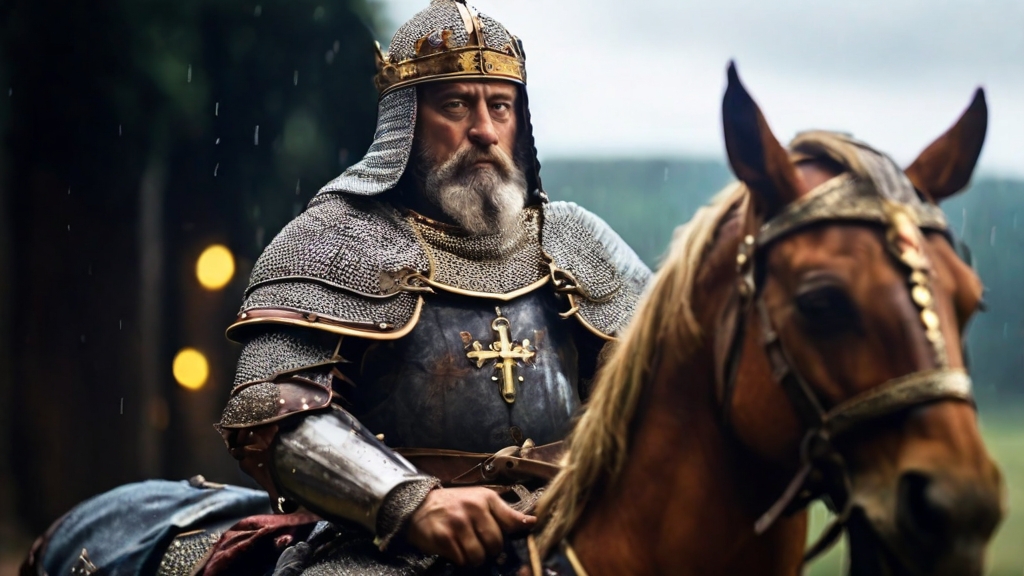
One of Charlemagne’s most outstanding achievements was the expansion of the Frankish Empire through a series of military campaigns.
Charlemagne embarked on a relentless conquest that reshaped the political map of medieval Europe. Building on the military successes of Charles Martel and Pepin the Short, Charlemagne’s conquests further expanded the realm, creating a vast Carolingian dominion that stretched from modern-day France and Germany to Italy and Spain.
Here are just some his significant military triumphs:
- Conquest of Lombardy (773–774): Charlemagne waged a successful campaign against the Lombards in Italy, culminating in the capture of Pavia in 774. This conquest solidified his authority over northern Italy and established the Kingdom of Italy.
- Saxon Wars (772–804): Charlemagne conducted a series of military campaigns against the Saxons to the north and east of the Frankish Kingdom. The conflicts lead to the incorporation of Saxon territories into the Frankish realm.
- Spanish March Campaigns (778): Charlemagne launched a military expedition into the Iberian Peninsula, attempting to assist the Christian Kingdom of Asturias against the Umayyad Caliphate.
Charlemagne was born on April 2, 747, or possibly 748. He was born in the Carolingian dynasty, and his birthplace is believed to be in the region that is now part of Belgium.
The Carolingian Renaissance: A Cultural and Intellectual Revival

While Charlemagne is often celebrated for his military achievements, his contributions to culture and education are equally profound.
His reign witnessed a revival of learning known as the Carolingian Renaissance.
Recognizing the importance of education for the stability and advancement of his realm, Charlemagne took deliberate steps to promote scholarship and intellectual pursuits.
Under his patronage, monastic and cathedral schools were established, fostering the copying and preservation of classical texts.
The construction of impressive structures, such as the Palatine Chapel in Aachen, reflected a deliberate effort to emulate the grandeur associated with the Carolingian court.
The intricate illuminated manuscripts and scriptoria established during Charlemagne’s reign were an evolution of Carolingian artistic traditions, showcasing a commitment to preserving and propagating cultural heritage.
Administrative Reforms and Governance
Charlemagne’s administrative reforms were an extension of the Carolingian legacy of governance.
Recognizing the need for effective governance, Charlemagne implemented a system of local administration known as the “missi dominici,” – royal envoys who ensured the enforcement of laws and collected information on local conditions.
His efforts to standardize weights, measures, and currency contributed to economic stability and facilitated trade within the empire.
Charlemagne’s administrative reforms aimed at centralizing power and ensuring efficient governance became a model for future European rulers.
Charlemagne’s reign served as a bridge between the Carolingian past and the medieval European future.
Charlemagne’s Role in Christianization
Charlemagne’s reign was instrumental in furthering the Christianization of Europe.
He was a devoted supporter of the Church and worked closely with religious leaders to strengthen the Christian identity of his empire.
Notably, his collaboration with Pope Leo III during his coronation underscored the symbiotic relationship between the Frankish monarchy and the Church.
Missionaries were dispatched to convert pagan tribes, particularly in Saxony, contributing to the religious cohesion of his realm. The intersection of political power and religious influence during Charlemagne’s reign played a crucial role in shaping the medieval Christian landscape.
3. Charlemagne’s Coronation Ceremony

Detailed Account of the Coronation Event
The coronation of Charlemagne, on December 25, 800, stands as a pinnacle of medieval pageantry, a meticulously choreographed spectacle that unfolded within the walls of St. Peter’s Basilica in Rome.
The grandeur of the event was not merely a display of regal opulence but a profound intersection between secular and sacred authority.
The ceremony commenced with a solemn procession through the city streets to the sacred halls of St. Peter’s Basilica.
Within the confines of St. Peter’s Basilica, the atmosphere was charged with reverence as clergy and distinguished guests filled the sacred space to capacity.
Pope Leo III, a central figure in this momentous occasion, delivered a sermon that lauded Charlemagne’s military triumphs, unwavering support for the Church, and commitment to justice and moral principles.
The apex of the ceremony unfolded at the conclusion of the Mass.
As Charlemagne knelt in solemnity before the altar, Pope Leo III adorned him with a regal crown crafted from gold and precious jewels.
Pope Leo III, in a resonant proclamation, bestowed upon Charlemagne the title of “Imperator Romanorum” – Emperor of the Romans.
This meticulously choreographed coronation, signified the resurgence of the Western Roman Empire, elevated Charlemagne to a position of unparalleled influence, and laid the foundational stone for the enduring legacy of the Holy Roman Empire.
Symbolic Elements of the Ceremony
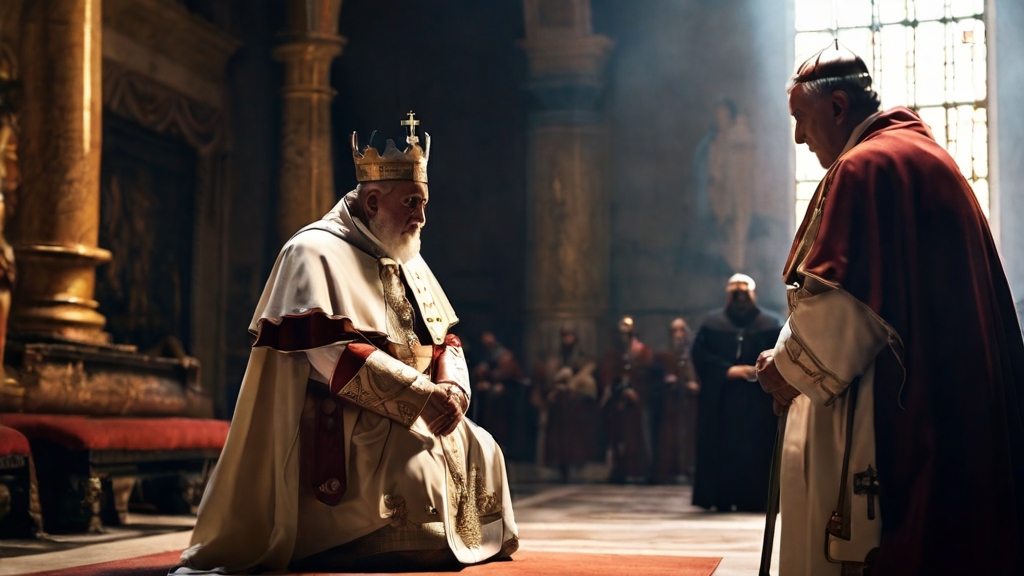
The coronation of Charlemagne was infused with profound symbolic elements and rich religious undertones.
Each facet of the ceremony was laden with significance, underscoring the intricate interplay between the secular and the divine, and shaping the narrative of the Holy Roman Empire’s birth.
- Anointing with Holy Oil – Drawing inspiration from biblical traditions, this act mirrored the anointing of Old Testament kings, emphasizing the sacred nature of Charlemagne’s kingship. The holy oil, representing divine consecration, marked Charlemagne as the chosen instrument of God’s will, charged with the sacred duty of ruling and defending Christendom.
- Coronation Oath – The solemn recitation of the coronation oath served as the verbal contract between Charlemagne and the Church. In this sacred pledge, the monarch vowed to protect and uphold the Christian faith, defend the Church, and govern justly.
- Biblical and Liturgical References – The entire ceremony drew extensively from biblical and liturgical references, weaving a narrative that resonated with the religious consciousness of the time. The use of sacred rituals and liturgical prayers mirrored the ecclesiastical traditions of the Church.
4. The Significance of the Collaboration Between Charlemagne and Pope Leo III

The collaboration between Charlemagne and Pope Leo III during the coronation was not merely a ceremonial display but a strategic alliance that wielded far-reaching implications for the political and religious landscape of medieval Europe.
Papal Support and Charlemagne’s Legitimacy
At the time of the coronation, Pope Leo III found himself embroiled in political turmoil and faced challenges to his papal authority.
Seeking protection and legitimacy, the Pope saw in Charlemagne a powerful ally. By anointing and crowning Charlemagne as Emperor of the Romans, Leo III secured a protector for the papacy.
The collaboration also elevated Charlemagne’s status to that of a ruler anointed by the highest religious authority.
Creation of the Holy Roman Empire
The coronation ceremony was not a mere formality; it was a deliberate act of political and religious innovation.
Through their collaboration, Charlemagne and Pope Leo III laid the groundwork for the establishment of the Holy Roman Empire.
The title of “Emperor of the Romans” bestowed upon Charlemagne echoed the legacy of the ancient Roman Empire, forging a link between the classical world and the emerging medieval order.
Charlemagne’s role as the Emperor of the Romans carried not only political significance but also a sense of continuity with the classical Roman legacy, providing a unifying narrative for the diverse regions under his rule.
This act of coronation signaled the birth of a new political entity that blended the authority of the monarch with the spiritual sanction of the Church.
Charlemagne: Shaping Medieval Kingship
The collaboration between Charlemagne and the Pope had a lasting impact on the concept of kingship in medieval Europe.
The idea that a ruler’s legitimacy could be enhanced through anointment and approval by the Church became a defining feature of medieval monarchies.
This model of collaboration between secular and spiritual authorities contributed to the development of the concept of the “two swords” — the notion that the ruler held both secular and spiritual authority.
Political and Religious Unity
This unity was not merely symbolic; it had practical implications for governance, as the Church and the state became intertwined in matters of law, justice, and moral authority.
5. Charlemagne and the Creation of the Holy Roman Empire
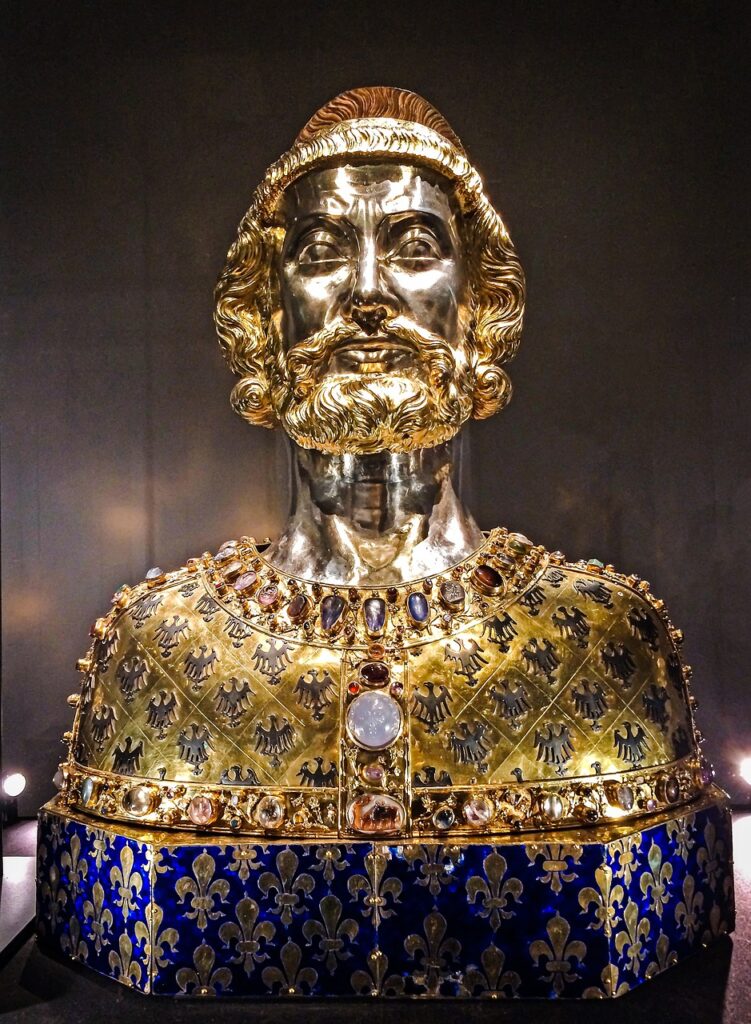
The formation of the Holy Roman Empire in the aftermath of Charlemagne’s coronation was a complex process, characterized by military conquests, political maneuvering, and a strategic synthesis of secular and religious authority.
Charlemagne: Territorial Expansion
Following his coronation, Charlemagne embarked on a series of military campaigns that expanded the territorial boundaries of the Holy Roman Empire.
Notable among these conquests was the incorporation of Lombardy, a region in northern Italy. Charlemagne’s campaigns in Lombardy not only extended the imperial borders but also solidified his influence in a region with significant economic and strategic importance.
The incorporation of Saxony into the empire was another crucial step in its formation.
The subjugation of the Saxons, a process marked by military campaigns and the Carolingian policy of forced Christianization, contributed to the territorial unity of the Holy Roman Empire.
These conquests underscored the dynamic nature of Charlemagne’s reign and his ambition to create a vast and cohesive Christian realm.
Political Unity and Governance
The coronation of Charlemagne as Emperor of the Romans carried inherent political implications.
It signified the emergence of a political entity that sought to transcend regional divisions and forge a unified realm under the imperial banner.
The missi dominici, royal envoys appointed by Charlemagne to oversee local administration, exemplified his efforts to establish a centralized system of governance.
Cultural and Intellectual Revival
Charlemagne’s commitment to cultural and intellectual revival, manifested through the Carolingian Renaissance, played a crucial role in shaping the character of the Holy Roman Empire.
The establishment of schools, the preservation and copying of classical texts, and the promotion of learning created a cultural unity within the empire.
6. Family Dynamics: Louis, Lothar, and Charles
Louis the Pious
Louis, Charlemagne’s son, succeeded his father as the ruler of the Holy Roman Empire.
Often known as Louis the Pious, his reign was marked by a commitment to the Christian faith and an attempt to continue the Carolingian legacy.
Louis sought to maintain the territorial integrity of the empire, and his efforts were particularly notable in dealing with external threats, such as Viking invasions.
Despite his intentions, Louis faced challenges in governance, including issues related to succession and the division of the empire among his sons. His reign showcased the delicate balance required to navigate the complexities of ruling a vast and diverse realm.
Lothar I
Lothar, another son of Charlemagne, played a central role in the family dynamics.
Initially co-ruler with his father and later inheriting the title of Emperor, Lothar’s reign was characterized by internal strife and external pressures.
The Treaty of Verdun in 843, which divided the Carolingian Empire among Louis the German, Charles the Bald, and Lothar, marked a significant turning point.
Lothar’s portion, known as Lotharingia, became a contested territory, witnessing conflicts and power struggles in the aftermath of the treaty.
Charles the Bald
Charles, often referred to as Charles the Bald, inherited the western portion of the Carolingian Empire.
His reign, like those of his predecessors, grappled with the challenges of maintaining stability and order. Charles faced external threats from Viking raids and internal challenges, including disputes with his brothers and rebellions by nobles.
Charles’s contributions to the Carolingian legacy included efforts to promote learning and culture. Despite facing the complexities of ruling during a turbulent period, he continued the family tradition of patronizing the arts and supporting intellectual pursuits.
Conflicts Within the Carolingian Family
The Treaty of Verdun, while aiming to address issues of succession, ultimately sowed the seeds of further conflicts. The division of the empire among Louis the German, Charles the Bald, and Lothar did little to prevent power struggles and territorial disputes in the years that followed.
Sibling rivalries and territorial ambitions led to clashes, with Lotharingia becoming a contested region. The internal strife within the Carolingian family weakened the unity of the empire, providing external forces with opportunities to exploit the divisions.
The family dynamics also influenced the broader political landscape of medieval Europe. The struggles within the Carolingian family contributed to the fragmentation of the empire, paving the way for the rise of regional powers and the eventual emergence of new dynasties.
7. Successor Dynasties
The Ottonian and Salian Dynasties
The Crowning of Charlemagne ushered in a period of dynastic shifts that would shape the trajectory of the Holy Roman Empire.
Following the Carolingian era, two prominent dynasties emerged: the Ottonian and Salian. These successive dynasties played crucial roles in consolidating and evolving the empire in the centuries that followed.
The Reign of Otto and Its Impact on the Empire
The Ottonian dynasty, notably under the reign of Otto I, marked a significant chapter in the history of the Holy Roman Empire.
Otto I, often referred to as Otto the Great, ascended to the throne in 936. His reign was characterized by a focus on centralization, governance, and the extension of imperial authority.
One of the key achievements of Otto’s reign was the defeat of the Magyars at the Battle of Lechfeld in 955, which solidified his control over the eastern territories of the empire.
Otto’s relationship with the Church was pivotal. In 962, he formed a close alliance with Pope John XII, resulting in his coronation as Emperor by the Pope. This coronation, reminiscent of Charlemagne’s, reaffirmed the close connection between imperial power and papal approval.
Otto’s reign laid the groundwork for the Ottonian Renaissance, a cultural revival reminiscent of the Carolingian Renaissance, fostering artistic, literary, and architectural advancements within the empire.
Power Struggles and Dynastic Transitions
The transition from the Ottonian to the Salian dynasty witnessed power struggles and political maneuvering.
The Salian dynasty, with figures like Conrad II and Henry III, faced challenges in maintaining the centralization achieved by the Ottonians.
The Investiture Controversy, a protracted conflict over the appointment of bishops, highlighted tensions between imperial and papal authority.
Power struggles within the empire and conflicts with the Papacy underscored the intricate balance of secular and religious authority that had been established since the time of Charlemagne.
The resolution of the Investiture Controversy under Henry V in the Concordat of Worms in 1122 marked a compromise between the imperial and papal powers, setting a precedent for the relationship between the Holy Roman Emperors and the Church.
8. The Legacy of Charlemagne
Influence on Medieval European Politics, Culture, and Religion
Charlemagne’s legacy reverberates through the corridors of medieval European history, leaving an indelible mark on politics, culture, and religion.
Charlemagne’s influence on medieval European politics is profound, notably:
- The establishment of the Holy Roman Empire, with its synthesis of secular and religious authority, became a model for governance.
- The coronation ceremonies initiated by Charlemagne set a precedent for the close relationship between monarchs and the Church, influencing the concept of kingship and the dynamics of political authority for centuries.
- The Carolingian Renaissance, fostered by Charlemagne’s patronage, became a beacon of cultural revival.
- Charlemagne’s commitment to education and intellectual pursuits laid the foundation for a cultural renaissance that contributed to the intellectual vibrancy of medieval Europe.
- The close association between the Church and the ruler became a defining feature of medieval European governance.
- The administrative reforms initiated by Charlemagne, such as the missi dominici system, influenced subsequent rulers in their efforts to centralize authority and maintain cohesion within the empire.
- Charlemagne remains a symbol of a vision for a cohesive and prosperous Europe.
- Charlemagne is woven into the fabric of national identity for various European nations. The mythos of Charlemagne, whether as the founder of the Holy Roman Empire or the embodiment of a European unity, contributes to the historical consciousness of nations across the continent.
As a unifying force and a patron of learning, his influence endures in the pages of European history and in the collective memory of nations. Charlemagne remains a figure whose impact extends far beyond the confines of his reign, shaping the course of medieval Europe and influencing the cultural and political landscape for generations to come.

